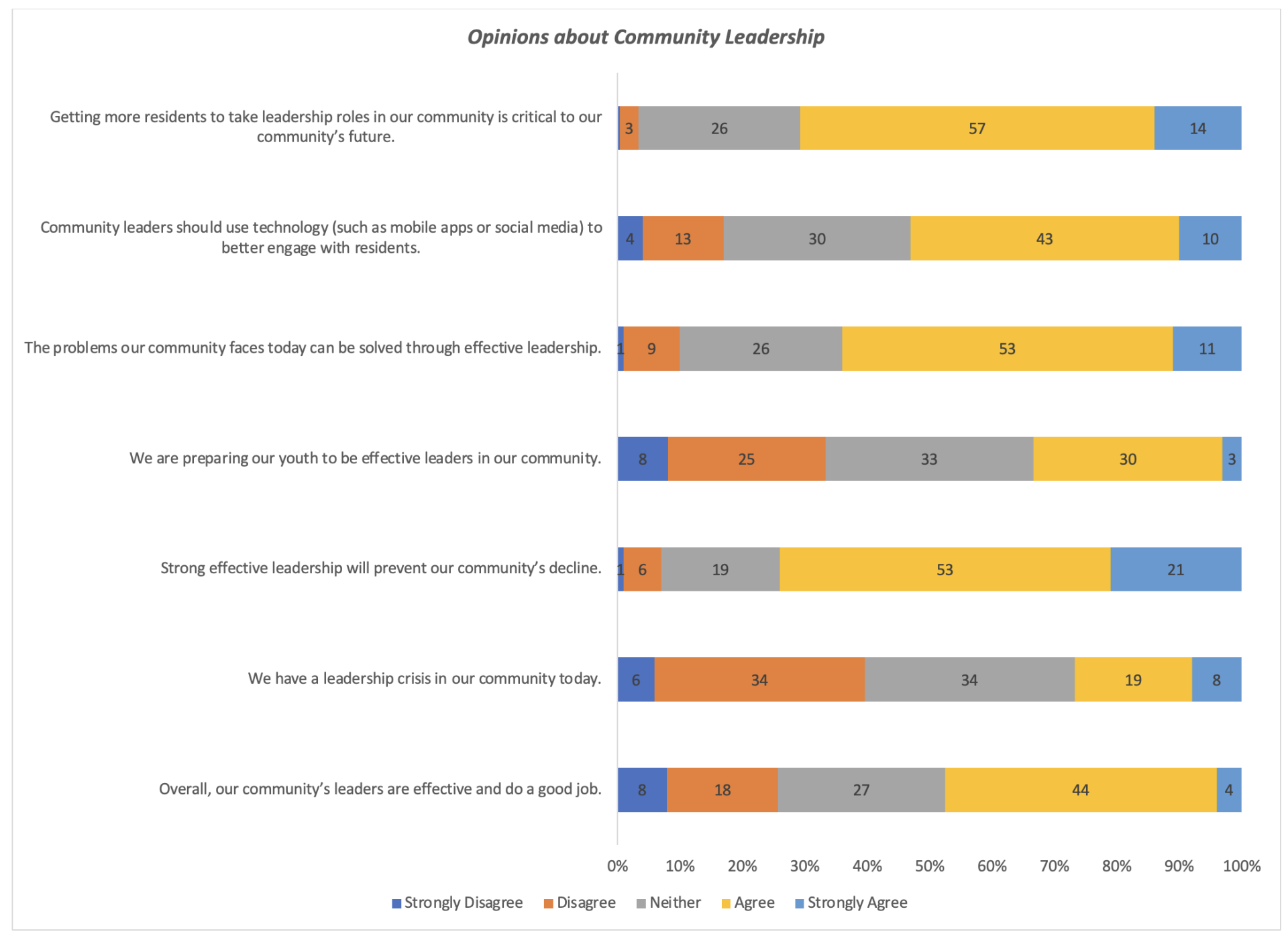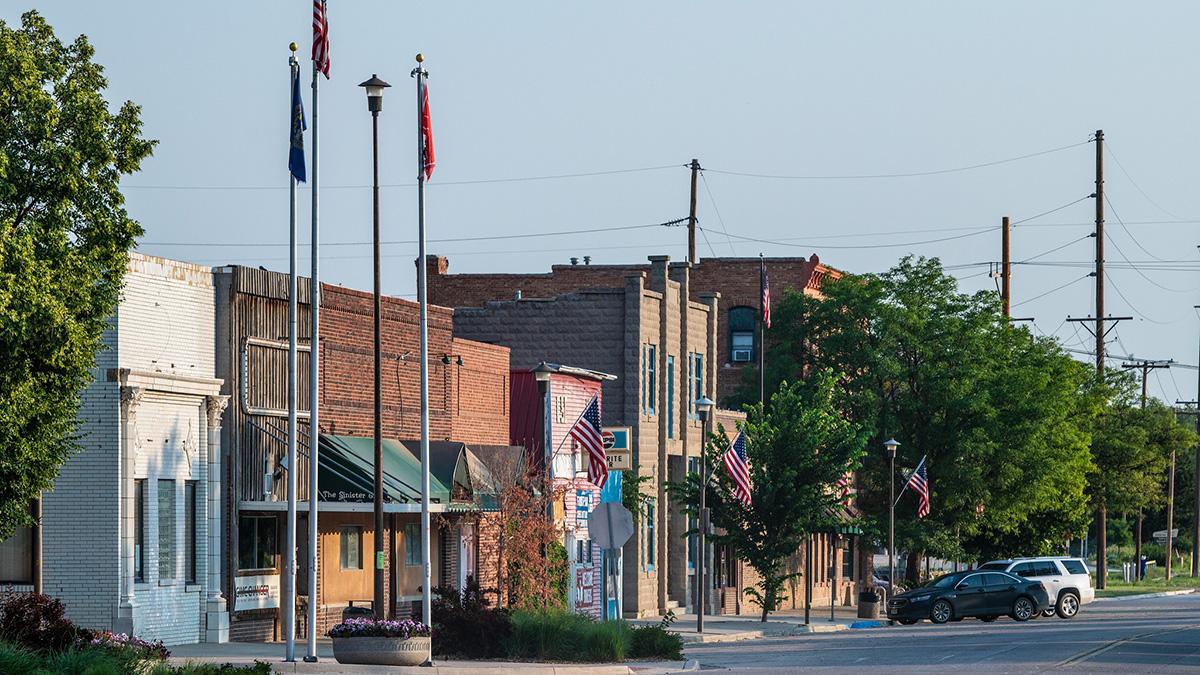Main Street buildings and businesses in Chadron, NE, on July 19, 2021. USDA Photo Media by Lance Cheung.
Community leadership is an important part of community development. Rural communities rely on volunteers for many local leadership positions. In smaller communities in particular, community members often take on multiple roles. Given these challenges, how do they feel about the leadership in their community? Do these perceptions differ by community size?
In the 2022 Nebraska Rural Poll, respondents were given a list of statements about the leadership in their community. They were asked to indicate their level of agreement or disagreement with each.
Overall, many rural Nebraskans have positive feelings about their community leadership. Almost one-half (48%) agree or strongly agree that their community’s leaders are effective and do a good job. And, although opinions are somewhat mixed on whether they have a leadership crisis in their community today, more disagree with that statement than agree with it. However, approximately one-third neither agree nor disagree with that statement.
Rural Nebraskans also recognize the importance of effective leadership to their communities. Just under three-quarters of rural Nebraskans agree or strongly agree that strong effective leadership will prevent their community’s decline. And, just under two-thirds agree that the problems their community faces today can be solved through effective leadership.
When looking to the future, opinions are mixed on whether the youth are being prepared to be effective leaders in their community. Equal proportions both agree and disagree with the statement that we are preparing our youth to be effective leaders in our community. And one-third neither agree nor disagree with the statement.
Many rural Nebraskans see technology as a tool that can be used by community leaders to engage more residents. Just over one-half of rural Nebraskans (53%) agree or strongly agree that community leaders should use technology such as mobile apps or social media to better engage with residents.
Finally, most rural Nebraskans believe getting more residents to get involved in leadership in their community is critical to its future. Just over seven in 10 (71%) agree or strongly agree that getting more residents to take leadership roles in our community is critical to our community’s future. Only three percent disagree.
There were some differences in these perceptions of leadership by community size. Persons living in or near mid-sized communities are the community size group most likely to see positive leadership trends in their community – seeing effective leadership in their community and opportunities for youth to become future leaders. Persons living in or near communities with populations ranging from 1,000 to 4,999 are more likely than persons living in or near both smaller and larger communities to agree that their community’s leaders are effective and do a good job and that they are preparing their youth to be effective leaders in their community. Just over one-half (53%) of persons living in or near communities of this size agree that their community’s leaders are effective and do a good job. Almost four in 10 persons of this community size group agree that they are preparing their youth to be effective leaders in the community.
And we found that persons living in or near communities with populations ranging from 500 to 999 are the community size group most likely to agree that they have a leadership crisis in their community today. Just under four in 10 persons living in or near this size of community agree with that statement.

This finding seems to illustrate the struggles some smaller communities face. Demographic trends lead to a smaller pool from which to draw potential leaders – leaving many residents to serve in multiple roles or for longer terms (keeping the same leadership in place for extended periods). In fact, UNL's Dr. Lindsay Hastings has stated that the country is poised to experience one of the largest leadership transitions in its history that will disproportionately affect rural communities.
However, the findings discussed earlier also suggest mid-sized communities have some advantages in the leadership sphere. They have a bigger population base from which to draw leaders and volunteers. Yet, they are small enough to effect change more easily. Hastings and her research team found that hope was an important determinant in how belief in leadership impacted civic engagement. Living in smaller communities (as opposed to the micropolitan communities) makes it easier to see the impacts of various community initiatives and efforts. This can inspire the hope that can lead to residents wanting to be more involved – to help create their desired future for the community.
In addition, community champions can work to facilitate change outside of traditional elected positions. These champions can help mobilize the community around their shared vision for the future and have the determination to keep pushing the community forward to make that vision a reality. This all points to an opportunity for rural communities to become prosperous through effective leadership, both formal and informal.


